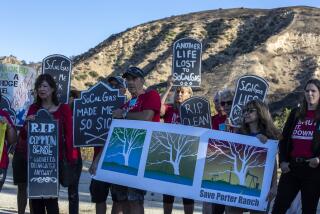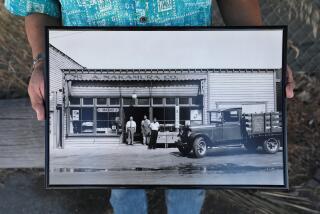Tierrasanta Cleanup of Old Munitions Moves at Snail’s Pace
- Share via
More than three years after two Tierrasanta boys were killed by the explosion of a World War II-era mortar shell, completion of a communitywide cleanup of old munitions from the extensive canyons in the area apparently is still more than a year away, local and federal officials said.
The U.S. Army Corps of Engineers is reviewing the results of random sweeps of canyons and open space that were conducted late last year to help identify the potential scope and cost of a major cleanup operation in Tierrasanta, a 2,600-acre planned community built on a site that once was a Marine Corps artillery range.
Federal officials are scheduled to present tentative findings from those sweeps--which, like Navy-run sweeps in 1984 and 1985, turned up numerous pieces of unexploded ordnance--to Tierrasanta residents at a community meeting next month. However, Corps of Engineers officials said that a final decision by the U.S. Department of Defense on the cleanup probably will not be made until at least the spring of 1988.
“The slow time frame is a major frustration, but a little extra time for the sake of caution is probably a good thing, too,” said Rep. Bill Lowery (R-San Diego), whose district includes Tierrasanta.
Last year, the Department of Defense earmarked $16 million for a comprehensive program to clean up the ordnance in Tierrasanta, built on part of Camp Elliott, a 43-square-mile Marine Corps training base and artillery range during World War II.
That price estimate was developed, however, before the Corps of Engineers had thoroughly scoured about 175 acres of Tierrasanta’s canyons and open space with magnetometers--devices that can detect underground shells--last year. Based on that new data, the final cost of the cleanup could be higher.
“It’s a complex procedure, and we’re still in the process of determining just how complex,” said Judy Wilson, a Corps of Engineers spokeswoman.
A major reason for the projected yearlong analysis of the test surveys and the delay in beginning the cleanup is that the Corps of Engineers, in the words of Lowery aide Karl Higgins, “is breaking new ground with this project”--literally and figuratively. The cleanup, Wilson said, will be the first one performed by the Corps of Engineers’ Huntsville Division under the Defense Environmental Restoration Account (DERA) program. It will set the standards that will be followed in other communities that, like Tierrasanta, were developed in areas once used for military live-fire training exercises.
“This is the first time they’ve had to go into an inhabited community where some people literally live over the ordnance and figure out how to remove it,” Higgins said. “They’re being very careful and don’t want to make any mistakes because this will be the precedent for any future operations.”
Before the 1983 tragedy, the presence of the old mortar shells, while clearly dangerous, had been regarded as a fact of life along with coyotes and snakes by most Tierrasanta residents. The absence of any previous injuries also caused many residents in the rolling, northeast San Diego neighborhood to discount the potential risk.
That casual attitude disappeared, however, after Matthew Paul Smith and Corey Alden Peake, both 8, were killed and a third youth was injured on Dec. 10, 1983, when an artillery shell they had unearthed in a brushy canyon near their homes exploded.
The boys were among six who found the shell in a canyon below Via Temprano while playing “fort.” The shell detonated when the boys banged it on a rock, instantly killing the two 8-year-olds and injuring Peake’s 12-year-old brother, Carl.
The accident mobilized the community, prompting Fire Department lectures to Tierrasanta schoolchildren on the dangers of handling munitions, and leading to repeated sweeps by Navy ordnance teams that found about 400 pieces of munitions, about 25% of them still explosive.
Designed to complete the cleanup work started by the Navy, the Army Corps of Engineers project began last fall with five-member teams sweeping one-acre areas to locate and dispose of leftover ordnance. The results of those sweeps, completed last December, now are being analyzed by a Virginia consulting firm to determine the likely magnitude and cost of a broader cleanup program.
After Tierrasanta residents have an opportunity to discuss the project at the planned April meeting, a draft report is expected to be completed in late June, followed by a public report by September, according to Corps of Engineers spokeswoman Wilson. The final report is not expected to be presented to the Defense Department until next spring, she added.
Stressing that “we’re not going to let this thing slide,” Lowery expressed hope that the cleanup could be expedited, with contracts perhaps being awarded this fall. However, Tierrasanta community activist Deanna Spehn described even the Corps of Engineers’ spring, 1988, estimate as “overly optimistic,” adding that she and other neighborhood leaders fear that final action may not be taken until 1989.
Debate at the April meeting is expected to focus on a philosophical difference that currently separates community leaders and some government officials.
Most community residents, Spehn said, favor periodic government-funded sweeps of Tierrasanta’s open spaces every few years to locate new pieces of ordnance, now underground, that work their way toward the surface as a result of rainfall and erosion.
“But the government wants to do the sweep, pronounce the area clean on a certain date and be done with it,” said Spehn, co-publisher and editor of the Tierra Times, a community newspaper in Tierrasanta. “We see it as a long-term problem, and they see it as something that can be handled with a quick fix. That’s the compromise that’s going to have to be struck.”
To date, several so-called “permanent solutions” have been discussed, ranging from simple removal of the ordnance to possibly fencing off certain areas of high concentrations of underground shells where the terrain would hamper their excavation, or make the process exceedingly expensive. That latter option is a particularly unattractive one to both community leaders and Lowery.
“The fencing off of any open space certainly isn’t something I want to see,” Lowery said. “That would have to be an absolute last resort. If we can locate the concentrations (of munitions), we ought to be able to remove them.”
However, even after the Corps of Engineers project is completed, the hidden threat in Tierrasanta’s hills will remain, Lowery cautioned.
“This is not a panacea by any means. It will take care of a lot of the immediate problem, but it’s not realistic to think we’re going to find every shell. And we know that there are other problems waiting deeper down in the ground. So it’s going to require some ongoing attention.”
More to Read
Sign up for Essential California
The most important California stories and recommendations in your inbox every morning.
You may occasionally receive promotional content from the Los Angeles Times.










